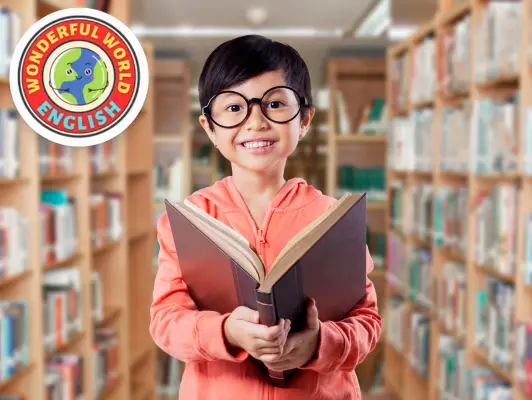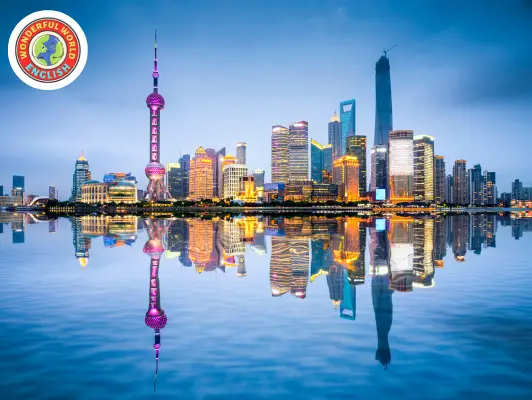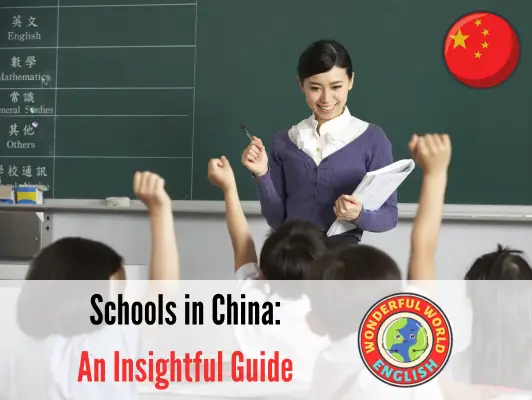Contents
Toggle
Meet David De’ Ath, founder, editor, and writer at Wonderful World English. With his extensive background as an English teacher, David provides valuable insights and practical tips on ESL for students and teachers alike.
Education in China is a complex and diverse system, overseen by the Ministry of Education.
It is characterized by a state-run public system that emphasizes the importance of education in modern China.
From the age of six, Chinese students embark on a minimum of nine years of compulsory education, starting with six years in elementary school, followed by three years in junior secondary school.
After this compulsory phase, many students continue to senior secondary school and, potentially, to higher education institutions.
Chinese education has evolved over time to become one of the largest in the world, emphasizing values and also aiming to equip students with necessary skills.
With an array of schools across various cities, the educational landscape in China is marked by its scale and ambition.
Schools follow a national curriculum with local adaptations, ensuring that students across the country receive a consistent level of education, with a focus on hard sciences, mathematics, and increasingly, English language learning.
Key Takeaways
- China’s education system is state-led and provides at least nine years of compulsory schooling.
- The curriculum is standardized, with a focus on science, math, and language, adapted to regional contexts.
- Education is highly valued, with schools spread across key cities and regions in China.
Overview of Education in China
Education in China has undergone remarkable transformations, with a compulsory education law mandating nine years of education.
Under the Ministry of Education, China has a high literacy rate and invests about 4% of its total GDP in the education sector.
Chinese National Curriculum
China’s national curriculum is standardized and overseen by the Ministry of Education.
It emphasizes Mandarin as the medium of instruction and Chinese culture.
Literacy and numeracy are foundational, with a heavy emphasis on mathematics and sciences.
The curriculum aims to prepare students for higher education and the modern workforce.
Related: What Subjects Are Taught in China? (An Overview)
International and Bilingual Schools
International and bilingual schools in China cater to both international students and Chinese nationals seeking an international education.
These schools often offer International Baccalaureate (IB) or curricula from other countries, providing a diverse learning environment.
This sector has seen growth, demonstrating China’s engagement with global education trends.
Public vs Private Schools
China’s education system comprises both public and private schools.
Public schools are funded by the government and are the mainstay for compulsory education, while private schools are on the rise, offering alternative curricula and teaching methods.
About 34.37% of schools are privately run, showing an openness to varied educational models within China.
Private school schedules vary from school to school in China.
Primary schools often begin their day at 8am and will finish at 4pm from Monday to Friday (excluding public holidays).
Older students are often expected to study from morning to evening, especially when running up to exam times.
Public school classes are 40 minutes long and can have up to fifty students a class.

Key Cities for Education
China’s metropolises are often the focal points of its vast and diverse educational landscape, with several key cities standing out for their exceptional educational facilities.
These urban centers boast some of the most prestigious schools and universities in the country, reflecting a deep investment in scholastic excellence.
Beijing’s Educational Hub
Beijing, the capital city, is a powerhouse in education, known for prestigious institutions like Tsinghua University and Peking University.
As the political and cultural center, it attracts a significant number of students from across the nation, offering an intense, competitive environment.
The city’s emphasis on education is further manifested in its substantial public and private investment into the sector.
Shanghai’s Diverse Schools
Shanghai prides itself on a cosmopolitan approach to education, housing a variety of schools that cater to both local and international communities.
Pudong, a district of Shanghai, is particularly notable for its educational facilities, with various international schools and state-of-the-art campuses enhancing Shanghai’s educational diversity.
Shanghai is one of the most popular cities for expats wanting to experience the best of China.
If you’re a native English speaker with a degree, how do you fancy experiencing Shanghai in all its glory?
We have plenty of jobs available for teachers in Shanghai, so click the link below for more information!
Related: Ready for the Adventure of a Lifetime?
Guangzhou and Shenzhen’s Growing Influence
In the southern region of China, Guangzhou and Shenzhen in Guangdong Province stand as burgeoning educational hubs.
These cities have seen rapid development, with their local governments prioritizing educational growth to attract talent and investment.
This region is becoming increasingly influential, with educational quality rising to meet international standards.

Schools and Curricula
In China, the landscape of international education is rich and varied, hosting a range of curricula including the International Baccalaureate, American, British, French, and German standards, each serving different educational philosophies and student needs within international schools.
International Baccalaureate and Its Reach
The International Baccalaureate (IB) program is renowned for its rigorous academic and personal standards, exemplifying a blend of global perspectives with a strong academic foundation.
Many international schools in China have adopted the IB curriculum due to its emphasis on students becoming active, compassionate, and lifelong learners who understand that other people, with their differences, can also be right.
American and British Standards
American and British curricula are also prevalent in international schools across China.
These schools often cater to expatriates yet also attract local students by offering the Advanced Placement (AP) program or the globally recognized General Certificate of Secondary Education (GCSE) and A-Levels.
China’s education reforms have enabled these international curricula to thrive, resulting in a dynamic and flexible educational environment.
German and French Educational Footprint
The German and French educational systems have left a distinctive footprint in China with specialized international schools that offer curricula aligned with the educational standards of their home countries.
These institutions aim to provide not just language proficiency but also academic qualifications recognized in Germany and France, accommodating the needs of German and French nationals as well as international families seeking alternative educational pathways.

Important Considerations
When exploring schools in China, several key factors demand attention, including financial aspects of education, the availability of diverse learning experiences beyond the classroom, and the implications of schooling on higher education opportunities.
Tuition and Enrollment Process
Tuition Fees: Public schools in China generally do not charge tuition for compulsory education, which covers primary and junior secondary education.
However, for senior secondary and higher education, including top universities, tuition fees are a significant consideration.
Private and international schools, offering programs like the International Baccalaureate (IB) and IGCSE, typically command higher tuition fees.
Enrollment: Admission into educational institutions, especially prestigious ones, is highly competitive.
The enrollment process can involve entrance examinations that assess a student’s academic excellence and education level.
It’s critical for prospective students to be aware of these requirements well in advance.
Extra-Curricular Opportunities
China’s educational landscape recognizes the importance of extra-curricular activities as instrumental in fostering diverse talents.
Schools across China are increasingly incorporating various extra-curricular opportunities, including sports, arts, and science clubs, which contribute to the holistic development of students.
Participation in such programs can enhance a student’s profile for university admissions and cultivate interests that support life-long learning and personal growth.
Graduate Outcomes and University Admissions
The pathway from school to higher education in China is heavily influenced by the results of the Gaokao, China’s national college entrance examination.
University Admissions are primarily determined by Gaokao scores.
Some institutions also consider other factors like extra-curricular achievements and performance in international standardized tests such as the SAT.
Graduate Outcomes are tied to the prestige of the university attended, which impacts employment opportunities and career paths.
For a complete guide on how you can become an English teacher in China, check out the link below!
Related: How to Teach English in China: Your Ultimate Guide

Conclusion
China’s education system, underpinned by a minimum of nine years of compulsory education, emphasizes a blend of traditional values and modern skills, preparing students for global engagement.
With a standardized curriculum focused on Mandarin, science, math, and English, the system offers diverse educational pathways through public, private, and international schools, particularly in major cities like Beijing and Shanghai.
International curricula, such as the IB and American or British programs, cater to a range of needs, reflecting China’s commitment to global education standards.
Financial considerations and competitive enrollment processes are pivotal in school selection, while extra-curricular activities enhance holistic student development.
Ultimately, China’s educational landscape is a dynamic mix of tradition and innovation, aiming to equip students for success in higher education and beyond, with the Gaokao exam playing a key role in university admissions.
We hope you find value in this information; you can contact us if you require any support.
Have a wonderful day!
Image Attribution: All images licensed via canva.com





